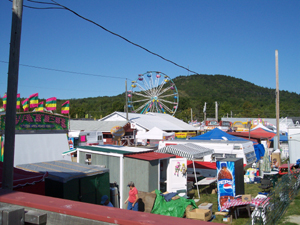 View of the Midway
we have seen on this
peninsula, it was down-to-earth, family-centered, and friendly.
View of the Midway
we have seen on this
peninsula, it was down-to-earth, family-centered, and friendly.
The climactic event in our month's stay here Down East in Maine has been our four-day weekend
at the Blue Hill Fair. Started in 1891, the fair draws thousands each day, even though there are
three other fairs in Maine the same weekend. Like just about everything else
 View of the Midway
we have seen on this
peninsula, it was down-to-earth, family-centered, and friendly.
View of the Midway
we have seen on this
peninsula, it was down-to-earth, family-centered, and friendly.
We began our first day by visiting many of the animals: cattle, oxen, draft horses, sheep,
llamas and alpacas. Then we found a seat for the first of many 4-H livestock shows. The showing was
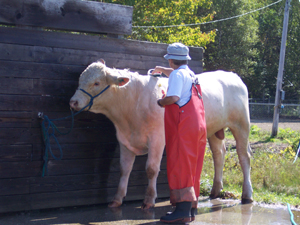 Preparing for judging
divided by breed and age of sheep, as well as age and experience of exhibitor. The judges were also the
4-H leaders, and spoke with each young exhibitor after each event to improve the animal care and
showmanship. There were plenty of ribbons for all.
Preparing for judging
divided by breed and age of sheep, as well as age and experience of exhibitor. The judges were also the
4-H leaders, and spoke with each young exhibitor after each event to improve the animal care and
showmanship. There were plenty of ribbons for all.
The popular 4-H sheep obstacle course required each contestant to lead the
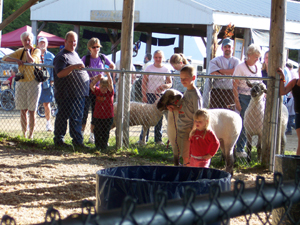 Youngest entrant and her brother
occasionally unwilling
animals to jump over a broom handle, scoop up a cup of grain and later move five pieces of popcorn
from one bowl to another while hanging on to the sheep, open a gate, lead the sheep through, close
the gate and return to the starting line. The youngest contestant was not quite 3 years old, shorter
than her ewe, and had some help from her brother.
Youngest entrant and her brother
occasionally unwilling
animals to jump over a broom handle, scoop up a cup of grain and later move five pieces of popcorn
from one bowl to another while hanging on to the sheep, open a gate, lead the sheep through, close
the gate and return to the starting line. The youngest contestant was not quite 3 years old, shorter
than her ewe, and had some help from her brother.
There were oxen and horse pulling events every day. The sledge is
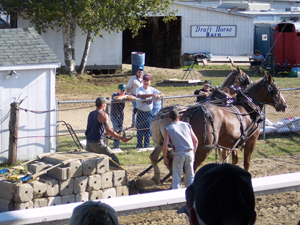 Starting the horse pull
loaded with concrete blocks equal
to one or two times the weight of the animals. The horses use an elaborate harness attached to padded
collars, while the oxen pull with the old wooden yoke. After the sometimes difficult task of hitching
the team to the sledge, the handler had three to five minutes to move the sledge up and down the
hundred-foot track, resting the team after each pull. Some teams moved the weight over 500 feet.
Starting the horse pull
loaded with concrete blocks equal
to one or two times the weight of the animals. The horses use an elaborate harness attached to padded
collars, while the oxen pull with the old wooden yoke. After the sometimes difficult task of hitching
the team to the sledge, the handler had three to five minutes to move the sledge up and down the
hundred-foot track, resting the team after each pull. Some teams moved the weight over 500 feet.
The cash prizes were an inducement for the farmers, many of whom still use the animals to move logs and rocks about their small farms. The costs of using horses and oxen for work are comparable to the costs of a modern tractor, and the animals are judged to be less destructive to the farmland for certain tasks. A goodly crowd filled the stands, eating popcorn and drinking soda, and all the entries got ribbons.
We sampled different fair food each day.
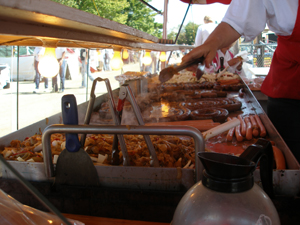 Sausages, peppers and onions
Our first choice was sweet Italian sausage sandwiches with
peppers and onions. Later we confirmed our guess that the French fries, made fresh from small and
tasty Maine potatoes and dipped in a garlic and herb vinegar, made the best meal. Close competitors
were the strawberry shortcake sold in the Agricultural exhibit hall, and the lemonade with each cup
made from scratch, with a half-lemon, just, and finely-granulated baking sugar. No alcohol is
allowed on the fairgrounds.
Sausages, peppers and onions
Our first choice was sweet Italian sausage sandwiches with
peppers and onions. Later we confirmed our guess that the French fries, made fresh from small and
tasty Maine potatoes and dipped in a garlic and herb vinegar, made the best meal. Close competitors
were the strawberry shortcake sold in the Agricultural exhibit hall, and the lemonade with each cup
made from scratch, with a half-lemon, just, and finely-granulated baking sugar. No alcohol is
allowed on the fairgrounds.
We climbed into the big grandstand for the antique tractor pull. It was somewhat unsettling to
learn that these antique tractors dated from the 1940s and 1950s and even early 1960s, long
after we were born. The load
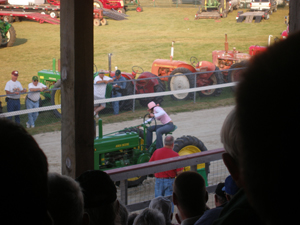 Driving her father's tractor
was a wagon with wheels at the back and a sledge at front.
As the wheels turned they drove gears which shifted the load forward to the sledge, making it
harder and harder to pull. By the end of the pull the tractor wheels were spinning in the dirt,
and an official waved a red flag to stop the driver's run. No tractor could manage more than 200
feet, so the action was kept right in front of the grandstand. Clever people! The drivers all
belonged to the Maine Antique Tractor Club, of course, mostly men, but a few women. One woman
Driving her father's tractor
was a wagon with wheels at the back and a sledge at front.
As the wheels turned they drove gears which shifted the load forward to the sledge, making it
harder and harder to pull. By the end of the pull the tractor wheels were spinning in the dirt,
and an official waved a red flag to stop the driver's run. No tractor could manage more than 200
feet, so the action was kept right in front of the grandstand. Clever people! The drivers all
belonged to the Maine Antique Tractor Club, of course, mostly men, but a few women. One woman
 Bob Bob Bob etc.
in particular, wearing a stylish pink cowboy hat, handed her baby to her father and climbed
into his tractor for a run; she didn't quite outpull dad, but almost!
Bob Bob Bob etc.
in particular, wearing a stylish pink cowboy hat, handed her baby to her father and climbed
into his tractor for a run; she didn't quite outpull dad, but almost!
One popular entertainment was the pig races, run by a young couple who set up a little track with fences and a bed of wood shavings. They use piglets from four to eight weeks of age, with a week for training at the start. Much older and they are too big to handle, as the operator must be able to hoist the animals into the starting gate. Of the five races, the first two are for pigs, the next for ducks (which the barker called ugly pigs), and the last for miniature goats (pigs from outer space). The contestants were all given names by the barker; we liked best the names of the black ducks in race number 4, which were Bob, Bob, Bob, and Bobbie (the female).
On Saturday we watched more animal judging, toured the produce and crafts exhibits, chatted
with the 4-H goat leader, and then it was time for the two-day Sheep Dog Trials. It was
the fiftieth anniversary for the couple who ran the trials, and they celebrated with a
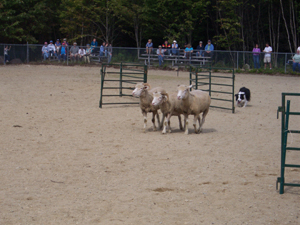 Working the sheep
performance by bagpipers, a parade of dogs and handlers, and an appearance by the Governor of Maine.
There were about 20 handlers, with over 40 dogs competing in 4-minute timed trials, so the
whole event lasted over 3 hours each day.
Working the sheep
performance by bagpipers, a parade of dogs and handlers, and an appearance by the Governor of Maine.
There were about 20 handlers, with over 40 dogs competing in 4-minute timed trials, so the
whole event lasted over 3 hours each day.
A sheep dog trial is a most unlikely combination of three species (sheep, dog, and human), no two of which can complete the performance alone. Although a border collie needs very little training to do the simple task of rounding up a flock of sheep and herding them across a field and into a pen, the trials are more difficult than ordinary herding. Working with just three animals, which are harder to herd than a larger flock, the collie must move them up and down the course, through gates and over bridges, and into one or more catch pens. Points are awarded for each obstacle, and the overall time is recorded to resolve tie scores.
We saw two general styles.
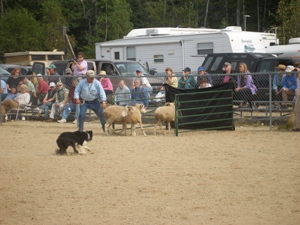 Into the first pen
Some dogs were terrifically fast and zipped all around, causing the
sheep to run up and down at quite a clip, but these animals ran the risk of losing control. Sometimes
the handler would withdraw the dog from competition. The most impressive dogs were able to use
their body language to control the sheep, lying close to the ground in a crouch, at just the right
distance away, and just the right angle and threatening glare to herd the animals towards the
next obstacle. Even when these dogs had to get to the other side of the sheep, they did so
efficiently and quietly, never alarming the sheep to bolt or run. It seemed that the quiet
dogs had quiet handlers, who made a few small high-pitched whistles and chirps, with perhaps
a hand gesture, but never shouted out commands.
Into the first pen
Some dogs were terrifically fast and zipped all around, causing the
sheep to run up and down at quite a clip, but these animals ran the risk of losing control. Sometimes
the handler would withdraw the dog from competition. The most impressive dogs were able to use
their body language to control the sheep, lying close to the ground in a crouch, at just the right
distance away, and just the right angle and threatening glare to herd the animals towards the
next obstacle. Even when these dogs had to get to the other side of the sheep, they did so
efficiently and quietly, never alarming the sheep to bolt or run. It seemed that the quiet
dogs had quiet handlers, who made a few small high-pitched whistles and chirps, with perhaps
a hand gesture, but never shouted out commands.
We sat mesmerized for two days of trials, never losing our fascination with the competition, and picking out our favorite dogs. The handlers were a lot of fun, too, about evenly divided among men and women, none too young. The oldest, the President of the Northeast Border Collie Association, was a woman of 84, who was scarcely five feet tall, with a weathered face and a pigtail. She'd been coming to the Blue Hill Fair for 40 years. Other handlers included a painting contractor, a medical technologist, a teacher, a few farmers, and even a retired intelligence analyst whose dog placed second overall.
Although the announcer introduced the handlers, the handlers knew that it was the dogs who won
or lost the trials.
 The ox scooting demonstration
The bonds between handlers and dogs were clearly very close, but the dogs
did not require any special encouragement to participate; one of the fascinating parts of this
event is that the dogs naturally love to work the sheep. A breeder of registered border collies
sells puppies, who typically live with a single owner for up to 15 years of a working life.
Owners are known to turn down thousands of dollars for their dogs.
The ox scooting demonstration
The bonds between handlers and dogs were clearly very close, but the dogs
did not require any special encouragement to participate; one of the fascinating parts of this
event is that the dogs naturally love to work the sheep. A breeder of registered border collies
sells puppies, who typically live with a single owner for up to 15 years of a working life.
Owners are known to turn down thousands of dollars for their dogs.
Sunday was the most crowded, with sunny skies and extra parking inside the racetrack. We watched an Oxen Scooting demonstration, showing how the team could pull a wooden sled through a forest (simulated by red traffic cones) to allow lumberjacks to harvest trees selectively. Besides being rocky, Maine is hilly and full of watercourses and bogs, so the country is really amenable to animal labor. The draft animals were groomed and gussied up for the fair just like the show animals.
In the agricultural exhibit, there were exhibits of beans, tomatoes, pumpkins, squashes,
and other vegetables, all divided into enough categories that just about everybody won at
least a little sticker. On the first day we saw a number of visitors look at the exhibits
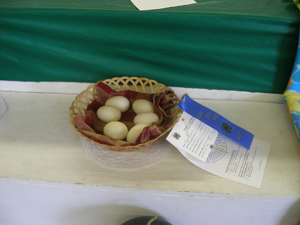 Prize-winning duck eggs
and then hurry home to their own gardens to pick some vegetables to show. Of course we've
been noticing the large number of homes that have a vegetable garden. It seems to be something
that affords great satisfaction to residents.
Prize-winning duck eggs
and then hurry home to their own gardens to pick some vegetables to show. Of course we've
been noticing the large number of homes that have a vegetable garden. It seems to be something
that affords great satisfaction to residents.
Wherever we went we saw families: families of fairgoers, families of exhibitors, families
on the midway or running the food stands. The feeling was so warm and caring that we kept
coming back day after day. We were even at the fair on a rainy Monday, where we watched
families sitting inside the livestock show ring on plastic chairs, with dozens of goats chained
to nearby fences, and children running back and forth parading their goats (kids leading kids,
at times) in front of the judges. Later on that day we saw a horse show,
 An entrant in the showmanship class
beginning with showmanship
classes and ending with equestrian trials. Unsurprisingly, we didn't see a single male competitor
here, and not all the girls could afford fancy riding gear -- in fact, one young competitor wore
big old rubber Maine boots instead of shiny leather ones! The judge lectured them all on
An entrant in the showmanship class
beginning with showmanship
classes and ending with equestrian trials. Unsurprisingly, we didn't see a single male competitor
here, and not all the girls could afford fancy riding gear -- in fact, one young competitor wore
big old rubber Maine boots instead of shiny leather ones! The judge lectured them all on
 A proud display
doing an
even better job of grooming the animals for show, and the competition was judged on the Danish
absolute scale, so sometimes there were several blue ribbons, while other times there were none at all.
A proud display
doing an
even better job of grooming the animals for show, and the competition was judged on the Danish
absolute scale, so sometimes there were several blue ribbons, while other times there were none at all.
Sunday's livestock parade was cancelled due to the rain, and there were events we missed, such as the evening music performances, and the daredevil drivers, and even the women's skillet toss, but we enjoyed each day, and felt refreshed and restored by four days at the fair.
About fifty years ago, E. B. White, writing the children's book Charlotte's Web, has the timorous pig Wilbur brought to the Blue Hill Fair to be exhibited. White summered for many years in Brooklin, just up the road from Blue Hill. The resourceful and talented spider Charlotte embroidered SOME PIG into her spider web just above Wilbur's pen. If E. B. White could return today to this event which has such strong traditions and loyal supporters, he would be sure to say SOME FAIR.